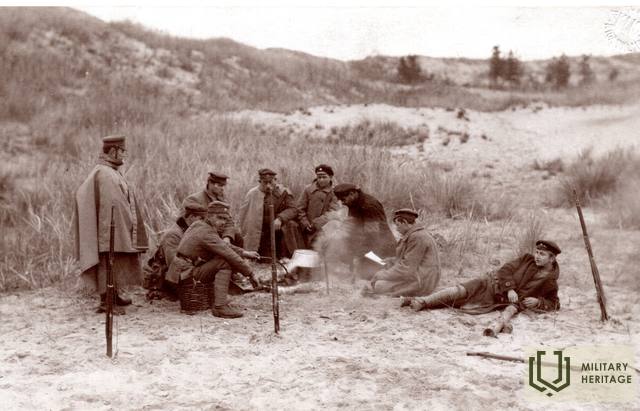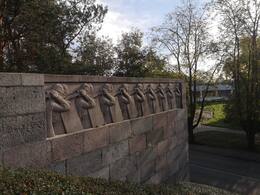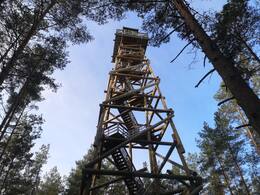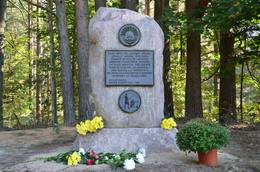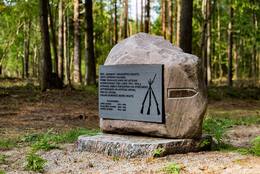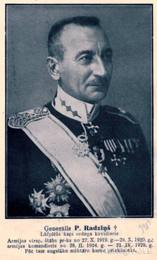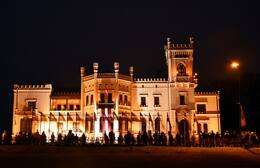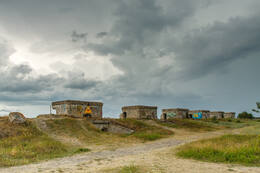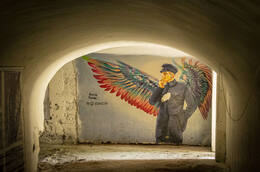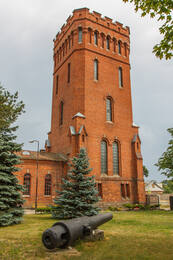Bermontiade I Wars of Independence
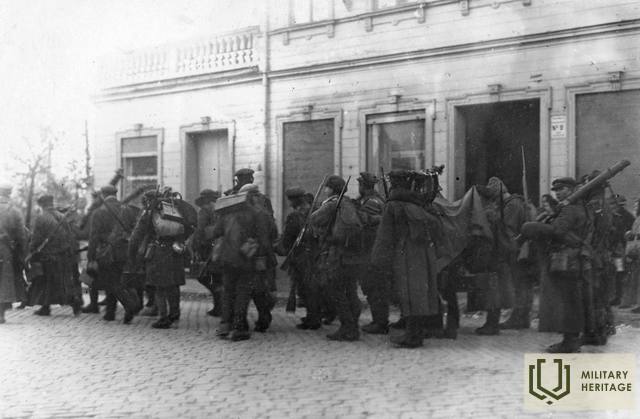
The Bermont Campaign is part of the Latvian War of Independence, in which the Latvian Army, with the support of the Entente allies, fought from October 8, 1919, to December 3, 1919. It began with the Bermont Army's attack on Riga and ended with its defeat and expulsion from Latvia. The forces led by Pavel Bermont were better equipped and outnumbered, but the soldiers of the newly founded Latvian Army responded with fighting spirit and patriotism.
The decisive turning point occurred on November 10 and 11, 1919, when the Latvian Army liberated Pārdaugava from the Bermontites and the soldiers of the Bermont Army (West Russian Volunteer Army) retreated to Jelgava, the liberation of which on November 21 effectively marked the end of the Bermontiades. Heavy battles still had to be fought before the complete liberation of the territory of Latvia, but the Bermontiades was one of the most significant turning points in the Latvian War of Independence.
This was one of the bloodiest pages of the Latvian War of Independence (1918-1920) and at the same time a testament to the national will of the people of the newly formed Latvian state, the first major victory of the Latvian army as a single independent unit. The Bermont War has not only a military significance in the history of Latvia, but also a significance that confirms the heroism of the Latvian people. The fierce battles proved that the people of Latvia are capable of fighting for their own future. The majority were united in the fight not only for independence, but also for the ideals of democracy, social and national justice. For Latvia, this victory meant final liberation from German armed forces, as well as the opportunity to focus on the liberation of Latgale from the rule of Soviet Russia.
Pavel Bermonts-Avalovs (1877-1973) was a symbol of everything that the creators of the new Latvian state stood against in this struggle. The self-proclaimed colonel cherished hopes of restoring the former Russian Empire, despising the rights of small states to independence. In the path of reviving the collapsed empire, the new Latvian state had for Bermonts exactly the same enemy as the Bolsheviks in Moscow.
Commemorating the liberation of Pārdaugava from the Bermontites, November 11 is now celebrated as Lāčplēsis Day, honoring Latvian soldiers.
More information sources
Celvezi.lv. 2020. Bermontiade - an episode of the Latvian freedom struggle. Available: https://www.celvezi.lv/raksti/vesture/bermontiade/ [accessed 06.05.2021].
Related objects
Sudrabkalniņš hill - memorial for fight against Bermondt army
Located in Riga, Pārdaugava, at the intersection of Slokas and Kurzemes avenues.
In early November 1919, during the Latvian War of Independence, street battles between the Latvian Army and Bermont's troops took place in Pārdaugava. The decisive attack on Bermont's army took place in this area. In 1937, a monument was unveiled in Sudrabkalniņš, according to the project of Kārlis Zāle, honoring the fallen soldiers of the 6th Riga Infantry Regiment and highlighting their military qualities.
Designed as a memorial wall – a symbolic fortification, the gate of which depicts a lion blocking the way to the enemy’s attack. Built from stone blocks of the Daugavgrīva Fortress defensive rampart and hewn from the granite left over from the Freedom Monument. The cost of the memorial site amounted to almost 35,000 lats. For comparison, 4 “Ford - Shield V8 De Luxe” cars made in Latvia could be purchased for this amount.
Today, you can visit one of the most impressive memorials of the War of Independence.
Bumbu hill firewatch tower
A memorial site for the Latvian Freedom Struggles. During the Bermontiades in November 1919, the command post of the Latgale Division led by Krišjānis Berķis was located here. The 6th Riga Infantry Regiment, attacking from Bumbu Hill, captured Sudrabkalniņš.
A place of remembrance of the events of the Latvian War of Independence in Mārupe
Located in Mārupe municipality, on the side of the road between the golf club “Viesturi” and the Boži reservoir.
The memorial was unveiled in 2013. The history of the area is connected to the battle of the Latvian Army against Bermont's troops in 1919. Near the Adienņi house, Latvian Army units were deployed in battle positions.
During the War of Independence, due to the difficult situation, the Latvian government lacked the opportunity to supply the army with what was needed. The appearance and armament of the soldiers varied. Most often, the supply was based on the soldiers' ability to provide for themselves. At the end of September and the beginning of October 1919, a Latvian military order arrived from Great Britain to eliminate the shortages. A month later, a delivery of English armaments was also received. With the first cargoes, it was clear that Great Britain was getting rid of unnecessary supplies. Dirty, worn-out clothes and shoes were also received, which were often too small. When soldiers wore inappropriate shoes, health problems were created, which affected their combat capabilities. Clothing was repaired and sewn. The main unifying symbol was the 11-ray sun sign on the cap and a red-and-white bandage around the left arm.
Today, several memorial sites can be visited here. The sites are part of a scenic, specially designed historical and nature hiking route.
Guide Mikķelis Jakunovs, +371 28353679.
The second monument to the soldiers of the first independent Latvia in Marupe
is located in Mārupe municipality, in front of the golf club “Viesturi” building on the forest road, opposite the sign to the golf practice field.
The authors of the project idea are Mārupe region guide Miķelis Jakunovs and the owner of the land plot “Dumpmaļi” Visvaldis Dumpis.
In November 2014, during the Latvian Patriots' Week, honoring Latvian soldiers, a second monument to Latvian soldiers was unveiled in the forest near Dzilnupīte, on the border of Mārupe and Babīte counties, another of the First World War battlefields. The conceptual author and financier of the monument is Visvaldis Dumpis, and it was created by sculptor Ivars Feldbergs. The owner of the memorial site, Visvaldis Dumpis, would like people to gather here not only on June 14 and March 25, but also on July 10, on the anniversary of the founding of the national defense forces and on other historical events important to Latvians.
On November 9, 2018, an informative stand about the history of the place and sightseeing objects was opened near the monument. It is dedicated to the history of the place, telling about the once former house "Adieņi" and the Ķurbja family that lived there, the events of the First World War in the area, as well as historical objects that can no longer be seen in nature - the Dūči Bridge, the Dzirnavu pond and mill, and the Hunting Bath.
Memorial site of General Pēteris Radziņš
Located in Valka parish, driving along the Valka – Rūjiena (P22) road at kilometer 4, turn right, following the signs.
Pēteris Radziņš was born on May 2, 1880 in “Jaunvīndedzēs” of Lugaži parish. He studied at Lugaži parish school, Valka city school and Valka Nelsons real school. He joined the Russian army as a volunteer. In the autumn of 1919, he returned to Latvia and on October 27, he was appointed Chief of Staff of the Supreme Commander of the Army, assuming this position at the moment when the Bermontites threatened Riga. As Chief of Staff, he led all the battles in Riga, Zemgale and Latgale. On February 5, 1920, he was promoted to general.
Nowadays, a memorial stone dedicated to General Pēteris Radziņš (1880 - 1930) can be seen near the family home.
On November 11, 2017, a memorial plaque to Pēteris Radziņš was unveiled in Riga, at the corner of Daugava Gate.
Video: General P. Radziņš memorial event at the Riga Brothers' Cemetery in 2019
Video: On May 2, 2019, on the 139th birthday of General Pēteris Radziņš, a commemorative event was held on the 11th November embankment, near the Presidential Palace, with an honor guard and interested parties surrounding the memorial plaque.
The Valka Museum of Local Lore's exposition "Valka - the Cradle of Latvian Independence" also reflects the life and activities of General Pēteris Radziņš.
In addition to traditional methods of displaying the collection, the exhibition uses interactive multimedia solutions. Information and annotations are translated into Estonian and English.
Alūksne Museum
The Alūksne Museum is located in an architectural monument of national significance: the neo-Gothic Alūksne New Castle built in the late 19th century. The museum features an exhibition named ‘Memorial Room for Victims of the Totalitarian Regime’, which tells about the fate of the inhabitants of Alūksne municipality in Siberia and the Far East, while the time periods from prehistory to the present meet in the Alūksne history exhibit ‘Feast of the Ages’. It features a separate section devoted to the contribution of the 7th Sigulda Infantry Regiment to the military, culture and public life. The formation of the 7th Sigulda Infantry Regiment began on 20 June 1919 in the Naukšēni Manor. Initially, a battle group of 22 officers and 1,580 soldiers was formed from the reserve battalion of the Northern Latvian Brigade, and was named the Dankers Division. It was included in the 2nd Battalion of the 3rd Jelgava Regiment. On 23 August, following an increase in the number of companies, it became part of the 7th Sigulda Infantry Regiment. Having taken part in the battles against Bermondt, on 5 January 1920, the regiment was transferred to the Latgale front to fight the Bolsheviks. After the signing of the Peace Treaty with Soviet Russia, the regiment guarded Latvia’s eastern border. The Latvian War of Independence saw the deaths of more than 200 soldiers of the regiment, while 85 were awarded the Lāčplēsis War Order. In 1921, the 7th Sigulda Infantry Regiment was stationed in Alūksne. The regiment’s headquarters were set up in the Alūksne New Castle. After World War II, the castle was taken over by Soviet security institutions. As of the late 1950s, the castle housed various cultural institutions: the Culture and Cinematography Department of the Executive Committee, a pioneer house, a library, a cinema and a museum.
Liepāja Northern Fort and Battery Nr.1 in Karosta
The Northern Forts are the best known and visually most impressive part of the Liepāja Fortress. Built by the Russian tsarist army in the late 19th century, their historical name is Fortress Battery No 1.
In November 1908, less than 10 years after its construction, the Liepāja Fortress ceased to operate, because its construction was acknowledged as a strategic mistake. Some of the cannons were dismantled and taken to the Kaunas Fortress in Lithuania, while others were remelted. Fortification structures were detonated twice in an attempt to destroy the fortifications. Elements surviving to the present day include artillery batteries not fully destroyed in the explosions and underground structures. Just like the Karosta, the Northern Forts were a closed military territory during the Soviet occupation. Visitors to the Northern Forts should be very careful. As in other places on the Latvian coast, the steep shore of the Baltic Sea in the Karosta is dangerous due to potential coastal landslides. Therefore, it is not allowed to walk under the ruins of the forts.
In the northern part of the fortress was located one of the four coastal defence batteries, Battery No.1. The battery was to house six 6-inch (152 mm) guns of the 1892 model of the Canet system, six 11-inch (280 mm) guns of the 1887 model and two 57 mm Nordenfeld anti-ship guns. Only the guns of the Canet system had a long enough firing range to withstand possible shelling by the German Navy. Thus, at the time of the liquidation of the fortress, the armament was only partially installed.
The Redan, Karosta
Redans, or Redana Fort, is located in Karosta, 14. novembra Street, about 1.5 km from the Northern Forts, in the nature reserve "Tosmare".
Historically, redans were elements of fortifications where longer sections of fortress walls were divided into shorter sections by building V-shaped positions facing the enemy, which allowed for better protection of the fortification wall. Karostas Redan is a late 19th century Liepaja Sea Fortress, projecting towards Lake Tosmare. As the fortress lost its fortress role, the fortifications and forts around it were partially blown up and rendered unusable. However, Redan remained almost intact.
In November 1919, after the failure at Riga, Pavel-Bermont Avalov's forces launched an intensive attack on Liepaja. The battle was also fought at Redan, where 80 soldiers of the Liepaja Military Port Commandant's Office under the command of Lieutenant Commander Radzins fought. In a swift attack on 14 November, the Bermontians managed to take Redan. This was followed by a counter-attack by Latvian troops and Redan was retaken.
In June, July and August, a knowledgeable guide will be waiting at Redan every day from 11.00-17.00, ready to tell you more about Liepāja Fortress and the historical events in the Karosta.
Karosta Water Tower
The water tower is located in Liepaja, in the Karosta, at 29 General Baloža Street - where the street meets Lazaretes Street. The water tower was an important building in the Karosta, as it supplied almost the entire Karosta area with drinking water. The exact time of construction of the water tower is unknown, but it could have been between 1903 and 1905. The project was probably designed by the St Petersburg architect Stefan Galenzovsky.
The water tower was powered by a steam engine with two coal boilers, one of which was kept in reserve, so there is an equally tall chimney next to the tower. The transmission powered four pumps, two of which were kept in reserve. Four boreholes supplied water to the pumps, which pumped it to a reservoir on the fifth floor of the tower and from there to the officers' apartments and soldiers' barracks in the Karosta.
When the Latvian Army took over the management of the water tower, the Ministry of War also took over the management of the water tower. After the Second World War, the Soviet Army took over the management. The water tower has been closed since 1989.
Although the tower was not a military building, in November 1919 the Latvian Army corrected the artillery fire of the British warships in the fight against the attack of the Bermont troops.
https://industrialheritage.travel/lv/objects/karostas-udenstornis/51
Nordeķi – Kalnciemas dune ridge
The approximately 30 km long dune ridge, which can be traced in nature from Iļģuciems (with minor interruptions) to Tīreļi today, is one of the most impressive landforms of the Seaside Lowlands, which is rarely perceived as a single natural formation. The dune was formed on the shores of one of the last Baltic glacial lakes, as the waters of the Baltic glacial lake receded. The dune ridge consists of two parallel 50–100 m wide dune belts. They are usually 6–10 m high, but their highest points reach 16–19 m above sea level. In the vicinity of Kleisti, Imanta and Beberbeķi, the beautiful pine forests covering the dunes are a popular place for walking, recreation and sports, and in winter - cross-country skiing. The part of the dune in the vicinity of Lāčupīte is associated with the events of the Bermontiades. On the dune in Pārdaugava is the Lāčupe or Lācaras cemetery . Between Pinkie and Babīte, the Beberbeķi Nature Park has been established to preserve the dunes. The western part of the Nordeķi-Kalnciemas dune ridge, approximately 10 km long, is called the Long Dune . Near the Long Dune (south of Trenči) is the Antiņi Brothers Cemetery , the Latvian Riflemen's Hospital medicine warehouse , and the renovated Latvian Riflemen's dugouts . South of the Long Dune is a massif of swampy forests and marshes, including Rāvājs and Maztīrelis . Opposite Maztīrelis is Ložmetējkalns with a viewing tower and a resting place and the so-called German rampart section . Even further west, near the Long Dune are the Latvian Riflemen Brothers Cemetery and the Piķi Brothers Cemetery. With greater or lesser interruptions, trenches are visible almost along the entire Nordeķi-Kalnciemas dune ridge. In the southwestern part of the Long Dune – in the swampy forests that adjoin it from the south, bomb craters from the First World War are visible. Along the entire length of the Long Dune (south of it), small forest paths run, suitable for walks and longer hikes – a great opportunity to explore the sites of the First World War battles.
Whale Monument
The monument is dedicated to the 14 fallen cadets of the Latvian Military School in battles against Bermont's troops in November 1919.
On the side of the Jelgava-Iecava road near the Vareļi house, on May 20, 1935, marking the 15th anniversary of the first graduation of the Latvian Military School, Deputy Prime Minister Marģerts Skujenieks unveiled and army chaplain Pēteris Apkalns consecrated a pyramid-shaped (375x400x400 cm) monument covered with travertine slabs, designed by artist Jānis Borkovskis.
Description of the monument: The monument is built on a 3 m high earthen embankment, where on the eastern side there are entrance stairs with 20 steps and at the foot – 4 massive travertine steps. A sandstone plaque (100x140 cm) was attached to the monument on this side with the text: “Cadets who fell for the independence of Latvia in 1919: Palms Otto, Palms Pauls, Dēliņš Jānis, Pelšs Pēteris, Erdmans Ansis, Skalde Gustavs, Skudruls Verners, Irbe Jūlijs, Rutkis Jānis, Boms Olģerts, Kalniņš Evalds, Lācis Nikolajs, Beļiņka Gustavs, Dzelzkalns Roberts.”
On the opposite – western side, the same plaque engraved: "Military School", on the southern side was the Military School breastplate – a shield with a crossed sword in a raised hand in an oath, and on the northern side – the first breastplate of the Military School cadets.
After the Second World War (in 1951), the monument was blown up. Under the leadership of Laimonis Zalcmanis, it was restored and opened on November 17, 1990. Old details were attached to the northern and western sides, but on the southern side, the meaning of the cadets' chests was recreated by sculptor R.Kalniņa-Grīnberga. The shattered sandstone slab with the names of the fallen was placed at the foot of the embankment near the stairs. The author of the restored monument is Gunārs Heimanis, engineer Edmunds Krūms.
In 2013, the Ozolnieki municipality, with co-financing from the Culture Capital Fund, carried out the restoration of the monument. The restoration work was carried out by restorer Ivo Graudums.
The works were carried out in accordance with the monument restoration methodology developed by Edgars Purviņš – general cleaning of the monument's surface and benches, restoration of damaged seams, repair of the core wall, replacement of damaged cladding panels and protective treatment were carried out. As a result of the aforementioned works, the monument has been protected from adverse climatic conditions and harmful environmental effects in the long term, the visual appearance of the monument and the possibility of reading information have improved.
Memorial to Jānis Vītiņš
Jānis Vītiņš (1894-1941) was not only a great singer, but also a heroic soldier. For his heroism in the battles near Bolderaja in 1921, Jānis Vītiņš was awarded the Lāčplēsis War Order.
The Spārni hillfort, together with the house “Guntiņas”, was presented to J. Vītiņš by the Latvian state in the 1930s for his heroic deeds in the Latvian freedom struggle. A memorial was unveiled on June 21, 2019 in Īle, at the foot of the Spārni hillfort.
The memorial stone was created under the guidance of sculptor Iveta Smiltniece and symbolically reflects Jānis Vītiņš's contribution to Latvia:
"It is a boulder cut in half, with one side depicting Jānis Vītiņš's military exploits, and the other side depicting his achievements in opera music."
"Jānis Vītiņš was born on 14.10.1894 in Pullā, Dzērve parish, today Cīrava parish. Died: 29.11.1941 in Astrakhan, Russian Soviet Federative Socialist Republic, KPFSR. Sentenced to death by firing squad in Astrakhan prison.
J. Vītiņš was born into the family of a farmer Fričis, where three other children grew up – Kārlis, Matilde, Bille (Betija). He studied at Rāva Elementary School, Činka Commercial School in Liepāja, and entered the Pskov Ensign School. In his marriage to Erna, in 1922, his son Gunārs (Gunards) was born.
In 1915, during the First World War, J. Vītiņš was mobilized into the Russian army. He served in the 9th Ural Infantry Regiment, from 1917 - in the 2nd Separate Heavy Artillery Division. During the War of Independence, in 1919, J. Vītiņš was mobilized into the Latvian Army, served with the rank of senior lieutenant. J. Vītiņš was an organizer and trainer of the National Guard (from 02.1919), later served in the Newly Formed Forces and a separate battalion. During his service years, J. Vītiņš began singing in front of the public, joining a vocal quartet.
When the Latvian People's Council was established in Liepāja, J. Vītiņš became a member of it in the Social Democratic faction. In the summer of 1919, he was assigned as a formator of the Riga Newly Formed Forces volunteer company and later appointed as the first commander of such a company. He was also the chief of the military police, then transferred to the 8th Daugavpils Infantry Regiment. During the Bermontiades, J. Vītiņš was wounded in battles on the Jelgava highway.
In 1920, after demobilization, J. Vītiņš entered the Latvian Conservatory, studied singing (with Ernests Witting), sang in the National Opera Choir at the same time, and was soon entrusted with small roles. His debut was the role of Wilhelm in Ambroise Thomas's opera "Mignon". In 1929, he was hired by the Zagreb Opera House (Yugoslavia). During his career, tenor J. Vītiņš performed 36 opera roles, most of them in the 1930s, when he was in demand in opera houses in many European cities. From 1931 to 1937, the singer, under the stage name Jan Wittin, performed in Germany - at the Berlin Volksoper, Dessau, Leipzig, Cologne, Duisburg, Stettin, Breslau, Essen, as well as in Czechoslovakia, Yugoslavia, Switzerland, and the Netherlands.
In 1940, under the conditions of the Soviet occupation, J. Vītiņš became involved in the resistance movement “Guardians of the Fatherland”. On 06.03.1941. J. Vītiņš was arrested at his place of residence in Riga, on Baložu Street, falsely accused of spying for Germany. On 15.03. in accordance with Article 58. 1-a of the Criminal Code of the Communist Party of the Soviet Union “for treason to the homeland”, the singer was sentenced to the highest penalty by the Stalingrad garrison military tribunal. The death sentence was carried out on 29 (12?) November 1941 in Astrakhan prison. J. Vītiņš’s widow and son were repressed (deported).
In 2018, the memory of the outstanding tenor and patriot was honored with the performance of the opera “André Chenier” at the Sigulda Opera Music Festival. J. Vītiņš's name is inscribed on a memorial stele, which was unveiled on 11.11.2018. in Aizpute Misiņkalns Park. In 2019, a memorial sign was unveiled at J. Vītiņš's house at the foot of the Spārni castle mound in Īle parish. At the Latvian National Opera and Ballet House, J. Vītiņš's name is written on a chair in the 14th row, in the 1st place."
National Encyclopedia, author Daiga azvērsīte.
Monument "To Those Who Fell in Heroic Death for Latvia", Jaunjelgava Cemetery
A monument to the soldiers who fell in the battles against Bermont in 1919 was unveiled at the Jaunjelgava cemetery on November 18, 1926. The following words are inscribed on the monument:
I was born for freedom,
I fell for Freedom
To enjoy freedom,
Whose fate has decided it.
The following fell in heroic death for Latvia in November 1919:
Andrejs Kampars
Theodore Jespers
Andrejs Kruklis
Alexis Petersons
Anton Balčunas
Stanislavs Balulis
In 1988, Popular Front groups were formed in Jaunjelgava, which restored the monument erected in 1926 in the early 1990s.
It is known about the events of that time: “On October 19, 1919, two companies of the 1st battalion of the 4th Valmiera Infantry Regiment took up positions near Jaunjelgava — a total of approximately 250 men. At 7 o’clock, units of the German legion commanded by Colonel Pāvels Bermont opened artillery fire and shortly thereafter went on the attack. The attacks followed each other with interruptions until the evening, when the enemy retreated into the forest. Throughout the day, the defenders had two seriously wounded and one lightly wounded.
In the following days, the Bermontites shelled the positions with artillery and machine guns, but there were no intensive infantry attacks. The front line stabilized, and both sides only conducted active reconnaissance.
Thus, it was possible to attract the Bermont forces located in the Jaunjelgava area and prevent their diversion to Riga. Military operations in the Jaunjelgava front area ended with the enemy's retreat on November 14, 1919."
Memorial stone for Artūrs Köler, Cavalier of the Lāčplēsis War Order
The memorial stone was unveiled on November 21, 2009, on the 90th anniversary of the liberation of Jelgava. The memorial stone is dedicated to Captain (later Lieutenant Colonel) Artūrs Kēlers, Cavalier of the Lāčplēsis War Order, who commanded the Latvian Army units that attacked the city from the Kalnciem side during the Jelgava liberation operation.
In 1919, when Riga had already been liberated from the Bermontites, on November 21, fierce battles with enemy units took place on the outskirts of Jelgava.
The order for awarding the Lāčplēsis War Order states that on November 20, 1919, near Jelgava, Kēlers, "personally leading a battle group consisting of 6 companies, under heavy enemy fire occupied the line Ciemale-Dūmiņi-Sabraki-Vilkubūdas, took prisoners and obtained 6 machine guns; the next day, in a persistent attack, he occupied the Red Inn and the Meiji Manor, finally breaking the enemy's resistance and greatly contributing to the liberation of Jelgava."
Related stories
About the first Commander-in-Chief of the Latvian Army, Dāvids Sīmansons
The essays in the book "Commanders of the Latvian Army" convince us that history is significantly influenced by specific individuals. Although they were at the epicenter of the most important historical events for a short time, true Latvian patriots, with their rich military experience, managed to do a lot in the formation and strengthening of the Latvian army and in the turning points of historical events.
This story is about the first Commander-in-Chief of the Latvian Army, Dāvids Sīmansons (1859-1933).
7th Sigulda Infantry Regiment's Bermontiad Battle, awarding of Grand Duchess Valija Veščūna with the Lāčplēsis War Order in Alūksne
After the Latvian War of Independence, Grand Sergeant Valija Veščunas was awarded the Lāčplēsis War Order for the battles with the Bermontites near the Plāņi houses on November 19, 1919. Valija Veščunas was one of the first to cross the Lielupe River under enemy fire.
In memory of Pēteris Radziņš, general of the Latvian Army, two-time Cavalier of the Lāčplēsis War Order
General Pēteris Radziņš was born in Lugaži parish, Valka district, into a simple farmer's family, where he learned to do field work. He was a very smart young man, after graduating from school he decided in favor of war and thus began his army career, saving Latvia from Bermont's troops. P. Radziņš was one of the most outstanding officers of the Latvian army and was awarded numerous Latvian and foreign orders and commemorative signs.
Memories of the beginning of the creation of the War Museum
The narrator describes the circumstances under which the War Museum was established. The problems and the work of creating collections are mentioned.
Karlis Hall and Freedom Monument
The narrator describes the memories of Kārlis Zāles as a personality who created the most famous works of Latvian art. The description is dedicated to the memory of Zāles in 1942 (the year of K. Zāles' death). The memories were chosen to characterize K. Zāles' works based on the author's personal characteristics and perception of the world.
Par Sudrabkalniņa atklāšanas svētkiem
Ištrauka iš prisiminimų istorijos iš generolo Jāņo Baložo kalbos Sudrabkalninio paminklo atidengimo dieną. Visas tekstas yra atidarymo renginio atpasakojimas, prezidento Kārlio Ulmanio ir generolo Jāņo Baložo kalbos. Prisiminimai pasirinkti, nes juose vaizdingai matyti Sudrabkalnino apylinkėse kovojančios Latvijos kariuomenės būklė.
Ball Mountain
Bumbu Hill is a high hill in the Bolderāja dunes, Kleistu Forest, Riga. A memorial site for the Latvian Freedom Struggle. During the Bermontiades in November 1919, the command post of the Latgale Division led by Krišjānis Berķis was located here. The 6th Riga Infantry Regiment, attacking from Bumbu Hill, captured Sudrabkalniņš. A memorial plaque was installed in 1939, which was destroyed in 1969. The memorial site was restored in 1989.
Latvian Army armored train No. 5 or "Kolpaks"
Latvian Army Armoured Train No.5 or "Kalpaks" was a light armoured train in the Latvian Armed Forces in 1919.
Reasons for awarding the award to Commander of the Armoured Train A.Klestrov
After successfully repelling an enemy attack, the commander of the armed train A.Klestrov falls and Colonel Danker issued the grounds for the award
How Latvian government officials fooled the Bolshevik supporters of Pampali
The former principal of the Pampāļi School (until 1959), Alfrēds Brūns, has personally typed an impressive book about the history of the Pampāļi School and historical events surrounding it, with authentic photographs. In the book, A. Brūns describes the events of the War of Independence in Pampāļi, describing in detail the events involving Latvian statesmen, Bolshevik supporters, the actions of the German army, etc.
The story of a unique military facility in Karosta
For years, I have not noticed any sustained interest in the unique places just eight to ten kilometres north of the city centre among the residents of Old Liepaja. But hidden in the thicket of the forest, on the dune bank or on the marsh paths, the historic sites of the Karosta are no less interesting historical facts and stories worthy of long-forgotten legends. One of them - the former 23rd Coastal Artillery Battery of the USSR - will be the subject of this story.
Description of the combat activity of Vilis Narkevics on 6 November 1919
Description of the combat activity of the commander of the detachment, Lieutenant Commander Julius Rosenthal Vilis Narkevics, 3 November 1921




